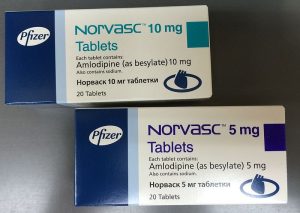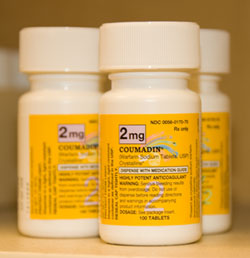
“Major Outcomes in High-Risk Hypertensive Patients Randomized to Angiotensin-Converting Enzyme Inhibitor or Calcium Channel Blocker vs. Diuretic”
The Antihypertensive and Lipid-Lowering Treatment to Prevent Heart Attack Trial (ALLHAT)
JAMA. 2002 Dec 18;288(23):2981-97. [free full text]
—
Hypertension is a ubiquitous disease, and the cardiovascular and mortality benefits of BP control have been well described. However, as the number of available antihypertensive classes proliferated in the past several decades, a head-to-head comparison of different antihypertensive regimens was necessary to determine the optimal first-step therapy. The 2002 ALLHAT trial was a landmark trial in this effort.
Population:
33,357 patients aged 55 years or older with hypertension and at least one other coronary heart disease (CHD) risk factor (previous MI or stroke, LVH by ECG or echo, T2DM, current cigarette smoking, HDL < 35 mg/dL, or documentation of other atherosclerotic cardiovascular disease (CVD)). Notable exclusion criteria: history of hospitalization for CHF, history of treated symptomatic CHF, or known LVEF < 35%.
Intervention:
Prior antihypertensives were discontinued upon initiation of the study drug. Patients were randomized to one of three study drugs in a double-blind fashion. Study drugs and additional drugs were added in a step-wise fashion to achieve a goal BP < 140/90 mmHg.
Step 1: titrate assigned study drug
-
-
- chlorthalidone: 12.5 –> 12.5 (sham titration) –> 25 mg/day
- amlodipine: 2.5 –> 5 –> 10 mg/day
- lisinopril: 10 –> 20 –> 40 mg/day
-
Step 2: add open-label agents at treating physician’s discretion (atenolol, clonidine, or reserpine)
-
-
- atenolol: 25 to 100 mg/day
- reserpine: 0.05 to 0.2 mg/day
- clonidine: 0.1 to 0.3 mg BID
-
Step 3: add hydralazine 25 to 100 mg BID
Comparison:
Pairwise comparisons with respect to outcomes of chlorthalidone vs. either amlodipine or lisinopril. A doxazosin arm existed initially, but it was terminated early due to an excess of CV events, primarily driven by CHF.
Outcomes:
Primary – combined fatal CAD or nonfatal MI
Secondary
-
-
- all-cause mortality
- fatal and nonfatal stroke
- combined CHD (primary outcome, PCI, or hospitalized angina)
- combined CVD (CHD, stroke, non-hospitalized treated angina, CHF [fatal, hospitalized, or treated non-hospitalized], and PAD)
-
Results:
Over a mean follow-up period of 4.9 years, there was no difference between the groups in either the primary outcome or all-cause mortality.
When compared with chlorthalidone at 5 years, the amlodipine and lisinopril groups had significantly higher systolic blood pressures (by 0.8 mmHg and 2 mmHg, respectively). The amlodipine group had a lower diastolic blood pressure when compared to the chlorthalidone group (0.8 mmHg).
When comparing amlodipine to chlorthalidone for the pre-specified secondary outcomes, amlodipine was associated with an increased risk of heart failure (RR 1.38; 95% CI 1.25-1.52).
When comparing lisinopril to chlorthalidone for the pre-specified secondary outcomes, lisinopril was associated with an increased risk of stroke (RR 1.15; 95% CI 1.02-1.30), combined CVD (RR 1.10; 95% CI 1.05-1.16), and heart failure (RR 1.20; 95% CI 1.09-1.34). The increased risk of stroke was mostly driven by 3 subgroups: women (RR 1.22; 95% CI 1.01-1.46), blacks (RR 1.40; 95% CI 1.17-1.68), and non-diabetics (RR 1.23; 95% CI 1.05-1.44). The increased risk of CVD was statistically significant in all subgroups except in patients aged less than 65. The increased risk of heart failure was statistically significant in all subgroups.
Discussion:
In patients with hypertension and one risk factor for CAD, chlorthalidone, lisinopril, and amlodipine performed similarly in reducing the risks of fatal CAD and nonfatal MI.
The study has several strengths: a large and diverse study population, a randomized, double-blind structure, and the rigorous evaluation of three of the most commonly prescribed “newer” classes of antihypertensives. Unfortunately, neither an ARB nor an aldosterone antagonist was included in the study. Additionally, the step-up therapies were not reflective of contemporary practice. (Instead, patients would likely be prescribed one or more of the primary study drugs.)
The ALLHAT study is one of the hallmark studies of hypertension and has played an important role in hypertension guidelines since it was published. Following the publication of ALLHAT, thiazide diuretics became widely used as first line drugs in the treatment of hypertension. The low cost of thiazides and their limited side-effect profile are particularly attractive class features. While ALLHAT looked specifically at chlorthalidone, in practice the positive findings were attributed to HCTZ, which has been more often prescribed. The authors of ALLHAT argued that the superiority of thiazides was likely a class effect, but according to the analysis at Wiki Journal Club, “there is little direct evidence that HCTZ specifically reduces the incidence of CVD among hypertensive individuals.” Furthermore, a 2006 study noted that that HCTZ has worse 24-hour BP control than chlorthalidone due to a shorter half-life. The ALLHAT authors note that “since a large proportion of participants required more than 1 drug to control their BP, it is reasonable to infer that a diuretic be included in all multi-drug regimens, if possible.” The 2017 ACC/AHA High Blood Pressure Guidelines state that, of the four thiazide diuretics on the market, chlorthalidone is preferred because of a prolonged half-life and trial-proven reduction of CVD (via the ALLHAT study).
Further Reading / References:
1. 2017 ACC Hypertension Guidelines
2. ALLHAT @ Wiki Journal Club
3. 2 Minute Medicine
4. Ernst et al, “Comparative antihypertensive effects of hydrochlorothiazide and chlorthalidone on ambulatory and office blood pressure.” (2006)
5. Gillis Pharmaceuticals
6. Concepts in Hypertension, Volume 2 Issue 6
Summary by Ryan Commins MD
Image Credit: Kimivanil, CC BY-SA 4.0, via Wikimedia Commons
